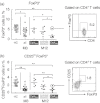Cyclosporin but not everolimus inhibits chemokine receptor expression on CD4+ T cell subsets circulating in the peripheral blood of renal transplant recipients
- PMID: 22471287
- PMCID: PMC3390527
- DOI: 10.1111/j.1365-2249.2012.04571.x
Cyclosporin but not everolimus inhibits chemokine receptor expression on CD4+ T cell subsets circulating in the peripheral blood of renal transplant recipients
Abstract
The peripheral chemokine receptors chemokine receptor 3 (CXCR3) and CC chemokine receptor 5 (CCR5) have been reported to be associated with allograft rejection. The impact of the expression of immunosuppressive drugs on peripherally circulating CD4(+) T cell subsets after renal transplantation is unknown. Expression of CXCR3 and CCR5 was investigated by flow cytometry in 20 renal allograft recipients participating in a prospective, randomized trial (NCT00514514). Initial immunosuppression consisted of basiliximab, cyclosporin A (CsA), mycophenolate sodium and corticosteroids. After 3 months, patients were treated either with CsA, mycophenolate sodium (MPA) plus corticosteroids (n = 6), CsA and everolimus plus corticosteroids (n =8) or CsA-free (CsA(free)) receiving everolimus, MPA and corticosteroids (n = 6). After initial reduction of CD4(+) forkhead box protein 3 (FoxP3)(+) and CD4(+) CD25(hi) FoxP3(+) regulatory T cells (T(regs)) (P < 0.05; P < 0.01), 3-month post-transplant percentages of T(regs) were reconstituted in CsA(free) and CsA(lo) arms compared to CsA(reg) 12 months post transplant. Expression of CCR5 and CXCR3 on CD4(+) FoxP3(+) and CD4(+) FoxP3(-) T cells 12 months post transplant was increased in CsA(free) versus CsA(reg). Increase in CCR5(+) CXCR3(+) co-expressing CD4(+) FoxP3(-) cells between 3 and 12 months correlated negatively with the glomerular filtration rate (GFR) slope/year [modification of diet in renal disease (MDRD); r = -0.59, P < 0.01]. CsA, but not everolimus, inhibits both T(reg) development and expression of CXCR3 and CCR5 on CD4(+) T cell subsets. Increase in CCR5(+) CXCR3(+) co-expressing CD4(+) FoxP3(-) T cells is associated with early loss in allograft function.
© 2012 The Authors;Clinical and Experimental Immunology © 2012 British Society for Immunology.
Figures





Similar articles
-
Peripherally circulating CD4⁺ FOXP3⁺ CXCR3⁺ T regulatory cells correlate with renal allograft function.Scand J Immunol. 2012 Sep;76(3):320-8. doi: 10.1111/j.1365-3083.2012.02732.x. Scand J Immunol. 2012. PMID: 22670785 Free PMC article.
-
Different immunosuppressive combinations on T-cell regulation in renal transplant recipients.Am J Nephrol. 2010;32(1):1-9. doi: 10.1159/000313940. Epub 2010 May 20. Am J Nephrol. 2010. PMID: 20484893
-
Preferential increase in memory and regulatory subsets during T-lymphocyte immune reconstitution after Thymoglobulin induction therapy with maintenance sirolimus vs cyclosporine.Transpl Immunol. 2010 May;23(1-2):53-8. doi: 10.1016/j.trim.2010.04.004. Epub 2010 Apr 18. Transpl Immunol. 2010. PMID: 20406686 Clinical Trial.
-
Concentration-controlled everolimus (Certican): combination with reduced dose calcineurin inhibitors.Transplantation. 2005 May 15;79(9 Suppl):S76-9. doi: 10.1097/01.tp.0000162434.62591.f3. Transplantation. 2005. PMID: 15880020 Review.
-
Basiliximab: a review of its use as induction therapy in renal transplantation.Drugs. 2003;63(24):2803-35. doi: 10.2165/00003495-200363240-00009. Drugs. 2003. PMID: 14664658 Review.
Cited by
-
Expressional time phase of leukocyte molecules induced by allogenic cardiac antigen and cyclosporin A in rats' in vitro model.Int J Clin Exp Med. 2013 May 22;6(5):404-12. Print 2013. Int J Clin Exp Med. 2013. PMID: 23724161 Free PMC article.
-
Predisposing factors for late mortality in heart transplant patients.Cardiol J. 2021;28(5):746-757. doi: 10.5603/CJ.a2020.0011. Epub 2020 Feb 13. Cardiol J. 2021. PMID: 32052856 Free PMC article.
-
Calcineurin inhibitor withdrawal or tapering for kidney transplant recipients.Cochrane Database Syst Rev. 2017 Jul 21;7(7):CD006750. doi: 10.1002/14651858.CD006750.pub2. Cochrane Database Syst Rev. 2017. PMID: 28730648 Free PMC article.
-
CXCR4 blockade reduces the severity of murine heart allograft rejection by plasmacytoid dendritic cell-mediated immune regulation.Sci Rep. 2021 Dec 10;11(1):23815. doi: 10.1038/s41598-021-03115-z. Sci Rep. 2021. PMID: 34893663 Free PMC article.
-
A comparison of mycophenolate mofetil and calcineurin inhibitor as maintenance immunosuppression for kidney transplant recipients: A meta-analysis of randomized controlled trials.Turk J Med Sci. 2021 Jun 28;51(3):1080-1091. doi: 10.3906/sag-1910-156. Turk J Med Sci. 2021. PMID: 33356028 Free PMC article.
References
-
- Hancock WW. Chemokine receptor-dependent alloresponses. Immunol Rev. 2003;196:37–50. - PubMed
-
- Sallusto F, Baggiolini M. Chemokines and leukocyte traffic. Nat Immunol. 2008;9:949–52. - PubMed
-
- Baggiolini M. Chemokines and leukocyte traffic. Nature. 1998;392:565–8. - PubMed
-
- Melter M, Exeni A, Reinders ME, et al. Expression of the chemokine receptor CXCR3 and its ligand IP-10 during human cardiac allograft rejection. Circulation. 2001;104:2558–64. - PubMed
-
- Fahmy NM, Yamani MH, Starling RC, et al. Chemokine and receptor-gene expression during early and late acute rejection episodes in human cardiac allografts. Transplantation. 2003;75:2044–7. - PubMed
Publication types
MeSH terms
Substances
LinkOut - more resources
Full Text Sources
Other Literature Sources
Medical
Research Materials

